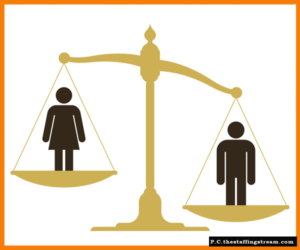
Closing the gender gap: women’s fight for equal labour right

Introduction
Women constitute nearly half of the world’s population and still are considered to be a vulnerable class. This is after multiple movements across the globe throughout history. It is not that the efforts made were useless, rather they yielded results far higher than expectations. However, women still face tremendous pressure from culture and are treated unequally on many fronts.
Many times, people presume that the most terrifying issue that a woman faces in the workplace is harassment and social pressure to behave in a certain manner. However, many times the issue of gender biases is more subtle, for instance not giving any important project to a person simply because she is a woman, undermining the contributions made by a woman in the professional sphere, or allotting a senior member as a mentor to a male employee and not showing same grace to a female one. These issues often take a back seat and are not addressed.
This article summarises the root causes and stances of various nation-states and international agencies over the issues of gender disparity. This article will also discuss the contributions made by various institutes or organizations or nation-states in addressing these issues and the results yielded from the same.
Gender disparity

Women, across the globe, face many challenges even before entering the professional arena. For instance, despite having made significant academic achievements, they are more likely to face inferior income opportunities than their male counterparts. Women also are less likely to find employment in the formal sector or to get the same opportunities in business expansion or career progression as men.1
As per the 2022 report, it is estimated that at the current rate of progress, it will take approximately 132 years to reach full parity. While this is an improvement from the estimation made in 2021, it still cannot cover the loss made during the pandemic period, 2020-21. The major focus of nation-states remains to bring gender equality for political empowerment, economic participation and opportunities, educational attainment and health facilities.2
Although a significant improvement has been made by nation-states in reducing gender disparity in the last decade, there remains room for more, currently, there is a sense of plummet.
Why such gender disparity exists?

The causes of gender disparity are many but the most major one is subconscious biases. A very good example of the same was given by Ms Sara Sanford, where she stated how a proposal made to a senior executive regarding the hiring of more female employees was overlooked while the same proposal when made by a male colleague was accepted.3
We can see that the senior executive is not against the hiring of more female employees and perhaps is unaware of his own biases altogether. The issue here is that this biasness against women is not an active thought but is so deeply embedded in our minds that we unconsciously make such decisions. If we are to counter this subconscious biasness, then we must consciously change ourselves to identify prejudices we hold against women and change them.

Another major cause of gender disparity is uneven access to education. 58% of people who are unable to complete their basic education are women, in fact, 2/3rd of illiterate are constituted, women.4 If we are to reduce gender disparity then it is imminent to provide education and make females aware of gender issues pertaining to our societies.
Division of jobs within employment is another issue causing gender disparity. This is due to the fact that there exist certain inherent beliefs that men are simply better equipped in doing certain jobs than their female counterparts and often times these jobs are better paying.
This leads to women working extra hard for jobs that are not properly financially recognized. An example of the same is a plea filed by the Madhya Pradesh High Court Bar Association this March. Here, the association pleads for an exemption for women in mandatory e-filing in Debts Recovery Tribunals (DRTs) and Debts Recovery Appellate Tribunals (DRATs). The plea was rejected stating that the presumption that females are not competent in the technological field is unreasonable.5
Contribution by different agencies in reducing gender parity
In 2015, the UN formulated a blueprint for – “A shared blueprint for peace and prosperity for people and the planet, now and into the future”6 known as sustainable development goals (SDG). Though this document is not legally binding, it has been localized by many nation-states. Goal five of SDGs is gender equality.
Targets for this goal include reforms to give women equal rights to economic resources, as well as access to ownership and control over land and other forms of property, financial services, inheritance, and natural resources, in accordance with national laws.7
For nation-states, there are various conventions8 as protection against gender-based discrimination binding them and making them legally responsible to deal with the issue of gender disparity. However, the participation of non-state actors in reducing gender disparity is also significantly crucial. For instance, multinational and transnational companies play a major role in influencing society in the current globalized world.
This is not only true for the international arena but the domestic arena as well. MNCs leverage their bargaining power by presenting both “inducements” or “promises of new investment” and “deprivations” or threats of withdrawal of investment9, through these tactics, they influence the domestic market and policies. Therefore, only through their participation, the gender gap can be closed.
Companies can make themselves gender sensitive by taking multiple initiatives. However, if they only invest in training and regulation then the gender gap cannot be closed in a real sense. They need to pay particular attention to addressing inequities in seven main areas of talent management: attracting candidates, hiring employees, integrating them into the organization, developing them, assessing performance, managing compensation and promotion, and retaining good performers.10
A few examples include11– Infosys an Indian IT company that puts focus on gender diversity. The company has established the Infosys Women Inclusivity Network to encourage a gender-sensitive work environment and the Family Matters Network to offer help to employees on parenting matters.
As a result, today women make up above 32% of the Infosys workforce. [2] Titan Industries Ltd. (“Titan”) is an Indian company that is part of the Tata Group and that manufactures watches, jewellery, and glasses.
Through its program, MEADOW i.e. (Management of Enterprise and Development of Women), the company has created opportunities for poor women from rural Indian communities to become wage earners and supported women‟s entrepreneurship through business education. Johnson & Johnson, headquartered in New Jersey, is one of the world’s‟s leading providers of health care products and services.
The company includes diversity as a significant process not only in recruiting but also in its supply chain, product development, sales, marketing, and advertising. The company is also promoting women to senior management positions, which signifies gender diversity.
1 Female labour force participation, World Bank, published on January 10, 2022, available at Female labour force participation – World Bank Gender Data Portal
2 Global Gender Gap Report 2022, World Economic Forum, published on 13 July 2022, available at- https://www3.weforum.org/docs/WEF_GGGR_2022.pdf
3 Sara Sanford, Improving gender parity through corporate accountability, TEDxSeattle, available at- Improving gender parity through corporate accountability | Sara Sanford | TEDxSeattle – YouTube
4#YouthStats: Education, United Nations, Office of the Secretary-General’s Envoy on Youth, available at- #YouthStats: Education – Office of the Secretary-General’s Envoy on Youth (un.org)
5 ‘Why Presume Women Are Bad At Technology?’ : CJI DY Chandrachud Disapproves Of Plea To Exempt Female Lawyers From E-Filing, Padmakshi Sharma, Live Law, published on 30 March 2023, available at- https://www.livelaw.in/top-stories/supreme-court-e-filing-cji-dy-chandrachud-female-lawyers-2251 33
6 Sustainable goals, UN available at- https://www.un.org/sustainabledevelopment/sustainable-development-goals
7 Goal 5: Achieve gender equality and empower all women and girls, Sustainable Development Goals, UN available at United Nations: Gender equality and women’s empowerment
8 The Convention on the Elimination of all Forms of Discrimination Against Women 1979 (UN), Discrimination (Employment and Occupation) Convention (ILO), Maternity Protection Convention (ILO)
9 Impact of socio-political environments on corporate governance of Multinational Corporations in Emerging Economies, Bhuvana Marni, INDIAN JOURNAL OF CORPORATE LAW AND POLICY, published on 13 August 2022, available at- https://ijclp.com/impact-of-socio-political-environments-on-corporate-governance-of-multinational-corporat ion-mncs-in-emerging-economies/
10 How to Close the Gender Gap, Colleen Ammerman and Boris Groysberg, Harvard Business Review, Magazine (May-June 2021), available at- How to Close the Gender Gap (hbr.org)
11 Corporate Social Responsibility and Gender in Workplace, Parminder Kaur, International Journal of Humanities and Social Science Invention, Volume 2 Issue 11, published in November. 2013, Page.36-40, available at- H021103036040.pdf (ijhssi.org)







